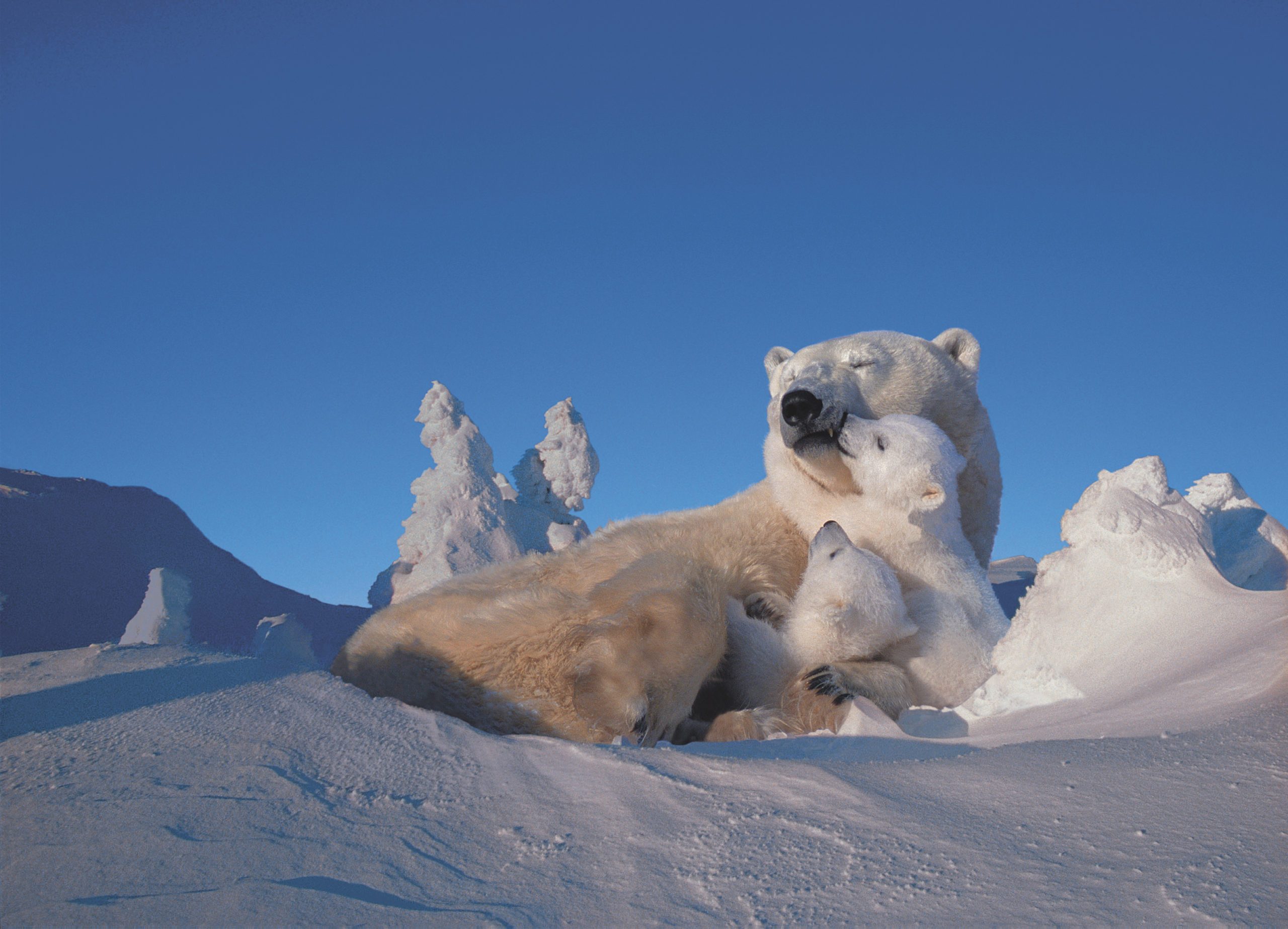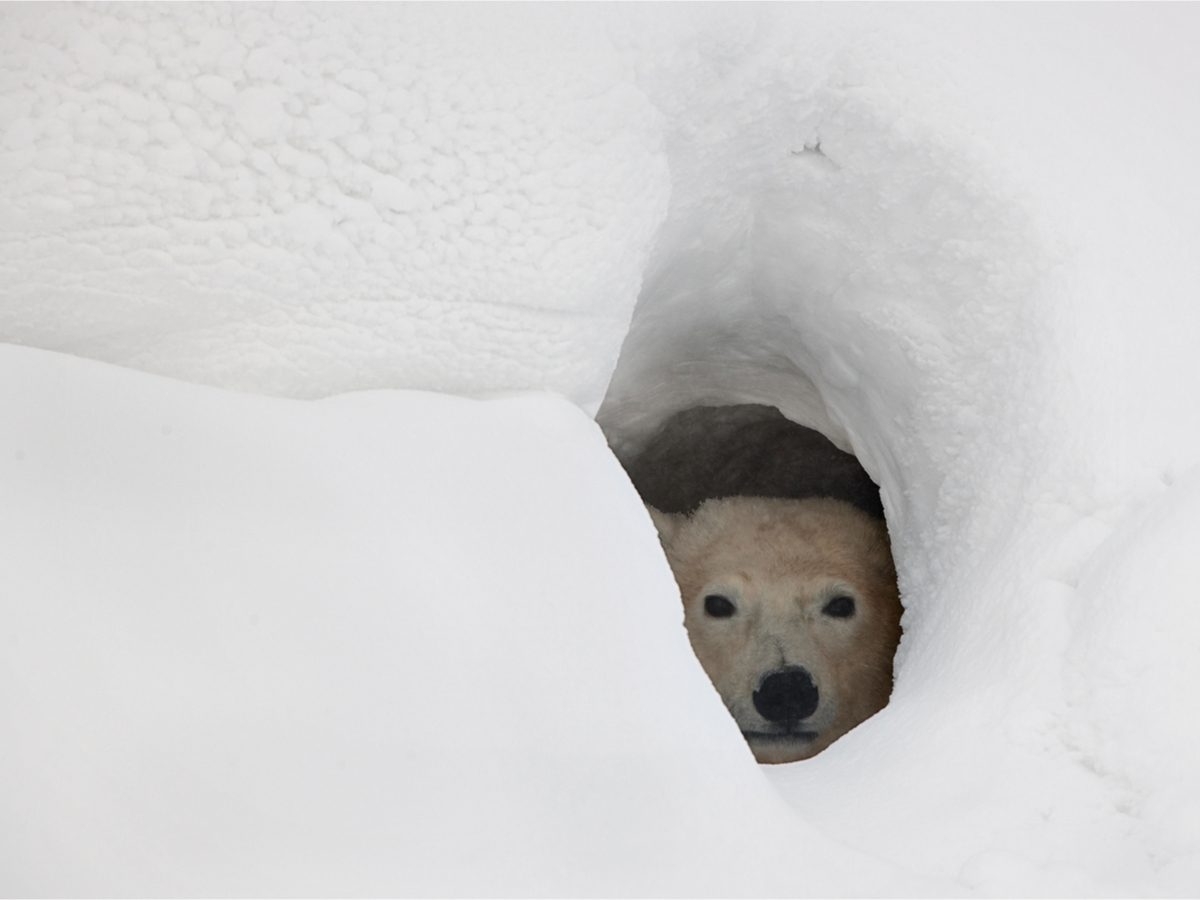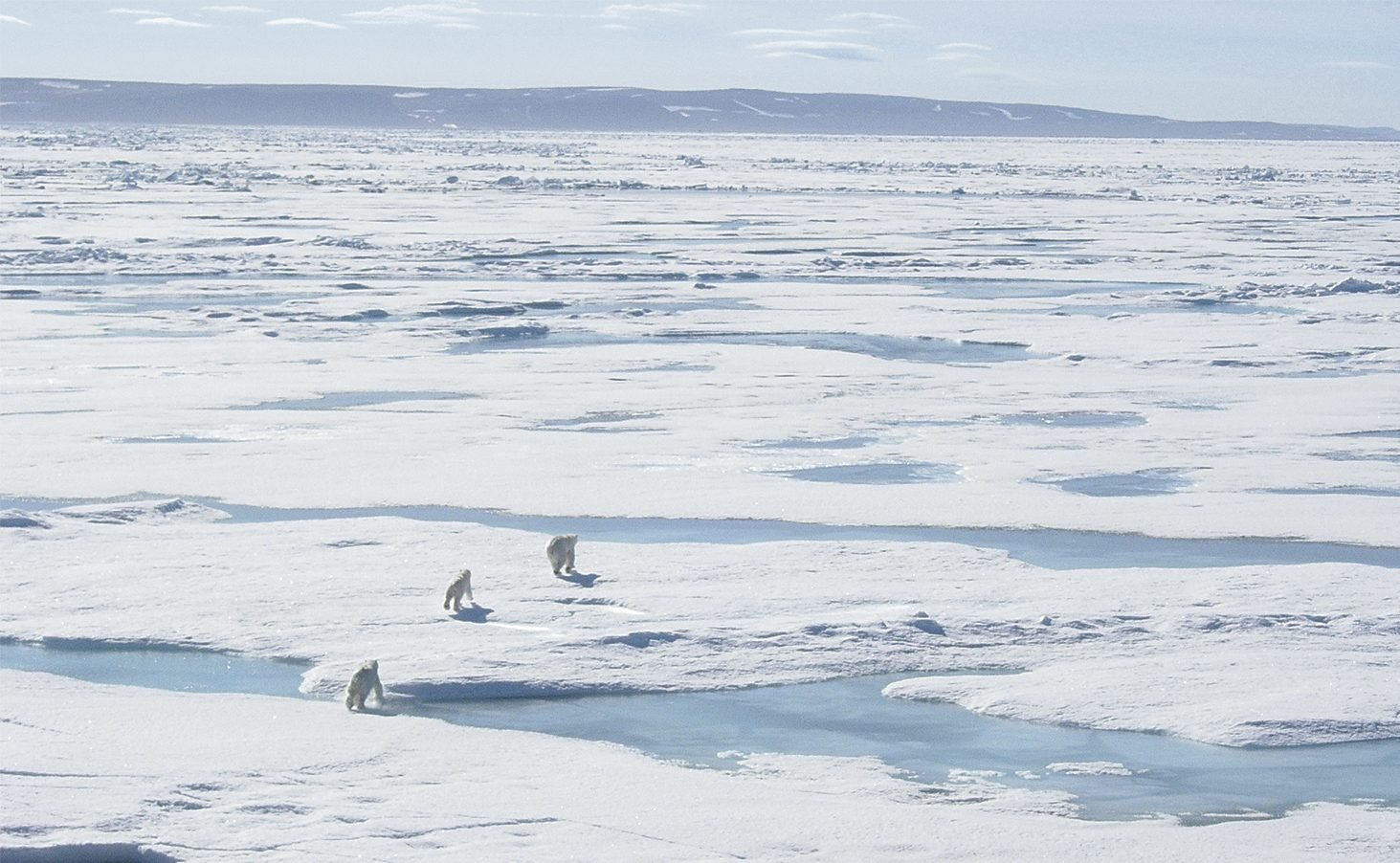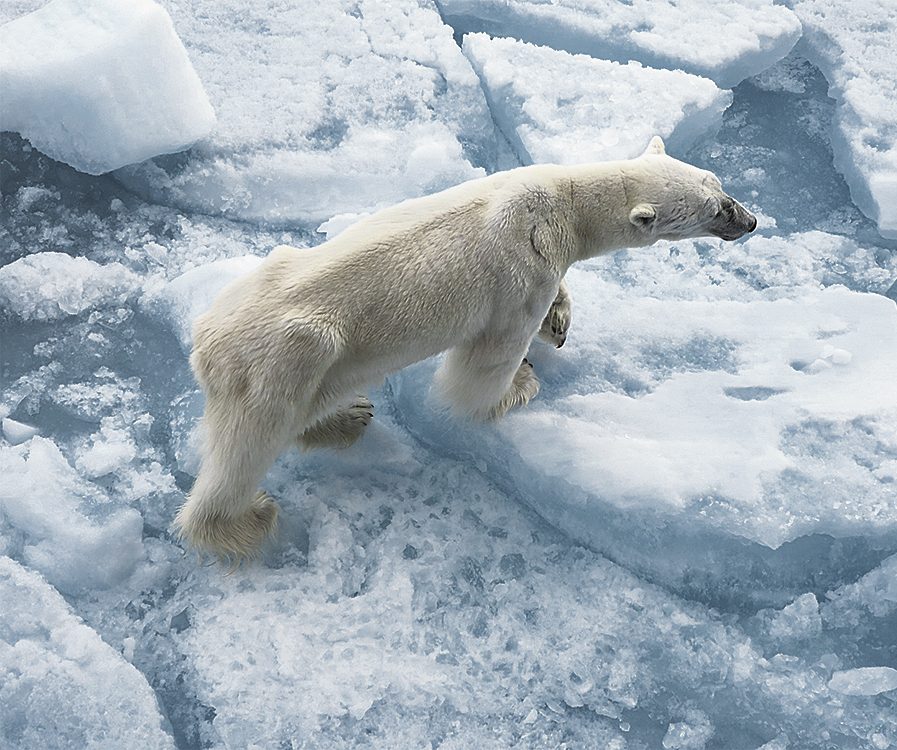
Mama Bear in Her Den
Nanu, a nine-year-old female polar bear, lives on the Hudson Bay lowlands, south of Churchill, Manitoba. Her den, which she dug out of a stream bank before the ground froze, is nearly two metres in diameter and half a metre higher than the narrow exit tunnel. Air warmed by Nanu’s body and breath forms a bubble of warmth that rises into the space. While the temperatures outside can be in the minus 20s in January, the well-insulated cave can be brought to just below freezing with nothing more than her presence.
Though she has not eaten for six months, she is able to nourish her cubs in utero and still keep her metabolism quiet enough to conserve energy for at least three more months of fasting to come. That’s because, in addition to her own considerable insulation—five centimetres of thick, downy underfur combined with a full mantle of long, hollow guard hairs—every bear has a layer of fat just below the skin.
To save energy, Nanu is able to lower her body temperature slightly from its normal 37°C. In her state of suspended animation in the darkened confines of the den, she delivers two blind, deaf, toothless, downy-haired young who are less than one per cent of her size, with no body fat to speak of.
The cubs, Sivu and Kingu, are immersed in the fur of her belly, where the sound of their mother’s slow-beating heart is as present and familiar as it was when they were in utero. Mother’s milk, with 32 per cent fat, keeps these tiny, helpless newcomers alive and powers their exponential growth.
By the time they are three weeks old, their fine hair is replaced by a dense undercoat and longer guard hairs. After 25 days, the soles of their little feet start developing hair as well, completing the insulation they need for moving around the den.
Before their eyes open early in the second month, they learn to navigate with other developing senses, often with Nanu’s gentle guidance. They start to differentiate the textures, smells, sounds and rhythms in the den. Their ears open and their ability to hear starts by their second month of life. By their third month, they are able to raise themselves up on their hind legs.
The cubs double in size monthly—going from two to four pounds in January, from four to nine in February. By March, when they start to explore the inside of the den, they are in the 24- to 26-pound range and increasingly aware of their surroundings.
The constant proximity of the three bears creates a family bond that will see them through to the separation that is at least two years off.

Waking Up From a Long Sleep
Outside, the air is dry and supremely cold. The cubs may perceive the presence of a fox rousting small mammals, like lemmings, that eke out a living in the tundra grasslands under the snow. One day, the piercing sound of a helicopter dropping grid stakes for a mining claim in the area startles the cubs, and they cluster back into Nanu’s bosom.
By March, the cubs are getting their lower incisors and canine teeth. In this third and final month in the den, the cubs’ hearing is starting to become much more acute. They can now hear a fox walking over the den. And, as they pounce and roll together, they try out different voices and calls.
With all this activity, Nanu must rouse herself from her sleepy state to scrape the frost that builds up on the walls. From time to time, she pokes at the air vent.
After the equinox on March 21, when the sun is visible for 12 hours, the days lengthen quickly. Soon it will be time to get the three of them on their way to the bay, 69 kilometres away. There is nothing but uncertainty ahead, as there has been for every emerging mother bear before her.
By March’s end, Nanu is fully awake. The cubs, fearless little furballs with claws and teeth, are ready to enter the wider world. Until very recently, the speed of change—in hunting traditions, the seasons, the weather, the local conditions—was such that the bears could mostly adapt.
With the dawn of the industrial revolution and the climate change that has accelerated in lockstep with technological “progress,” change is now happening much more rapidly than any living plant or animal’s ability to respond. Nanu and the cubs are living in circumstances that will challenge their very survival.
Read the inspiring story of how these incredible wildlife cops are fighting the polar bear trade.

Beginning the Journey
The adult bear who punches through to the April sunshine is a scant 550 pounds, a shadow of her ample self. Stiffly, Nanu drags herself out of the den, shakes vigorously and stands fully upright for the first time in five months. She turns to the den, chuffing for the cubs to follow. Working her way uphill for a few dozen metres, she stands on a gravelly ridge looking first one way and then another. Scanning the distance. Sniffing the air. She knows instinctively how vulnerable she and the cubs are.
That first trip out of the den lasts no more than half an hour. Over the next week, Nanu and the cubs work their way up the ridge, stopping at a place where the wind has scoured the ground, exposing alpine grasses. She grazes on these to reduce her hunger and to reawaken her digestive system.
Forays in these early days build and tone the cubs’ muscles for their journey to the ice, which is about to begin. But these walks are also about readying Nanu’s own body for the long walk back to the bay.
Finally, Nanu decides it is time to move. In the 10 days since she opened the den, the scent of the sea has arrived on the wind, particularly from the east. Silhouetted against the strengthening sun, the three bears walk away, the cubs roaming between Nanu’s feet, getting sidetracked with smells and other distractions, being called back.
The route they are taking is similar to the one that Nanu first walked with her mother almost eight years ago to the day. It isn’t long before they are crossing a pattern of beach ridges, each one a little lower in elevation than the previous one.
The cubs play less now because when they are not walking or nursing, they are sleeping. And when they walk, they feel the sun as it moves from in front to beside and then behind them as the days progress. For Nanu, it is a familiar sensation, like melodies of a long-remembered tune.
Kingu will likely never come back this far inland. As a male, he will den during the harshest months of winter. Sivu, by contrast, will learn to come here by heart, by the look and feel of the place—the ground-hugging spruce on the beach ridges, the faint smell of diesel from the trains running up and down from Le Pas to Churchill, the pungent dens of foxes.
Suddenly Nanu stops with every muscle in her body flexed and ready. The cubs, too, tumble to a stop. Nanu sniffs and utters a high-pitched grunting sound that the cubs have never heard before—at least not at that intensity. Nanu stands and sniffs, first in one direction, then in another and another, finishing with a long stand facing downwind. In the distance, three grey wolves are making their way toward them.
Encouraging the cubs to keep close, she stands resolutely so that the wolves can see her before taking a few vigorous running steps in their direction. She then continues walking toward the wolves, cubs behind her. Undaunted, driven by a mother’s combination of fear, caution and courage, Nanu chooses to pose a threat of her own.
Again, she stands, radiating the confidence of size. This time the wolves stop and then lope off in the other direction.
At this point in their lives, the cubs have no real capacity to run. Nanu will never leave them, except to fight on their behalf, so her ability to escape from a threat is compromised as well. The best she can do to protect the cubs is to encourage them to listen and stay close.
This man survived a crash in the Arctic—only to be stalked by a polar bear.

Standing Up to Threats
Day six, in spitting gray snow, they crest a ridge, and the cubs, riding on their mother’s back, sniff the air and sense that something is different. For the first time, Sivu and Kingu notice the odour of muddy ice on the foreshore flats of Hudson Bay. Mixed with the familiar scents are old oil, which may have washed in from a summer boat at sea, and the acrid plastic flotsam increasingly brought here by the slow rotations of the Hudson Bay gyre.
At the beach, Nanu breaks into a short canter. Stopping suddenly, she flops onto her back and rolls for the longest time with her feet in the air and the cubs clambering all over her. She gets up, shakes and sniffs along a crack in the ice. She disappears momentarily down through the crack and reappears with a great tawny snake of bull kelp that she drags up on the ice. The kelp is full of alginates and fibre that will fill her digestive system and ready it for the meal to come. The little ones tire of it quickly and butt their way in for milk instead.
They continue out onto the ice. Nanu stops and sniffs and stands much more often than she did while they were on the land. She and her cubs are entering a dangerous world of adult bears: males, ready to mate, whose first gambit would be to kill and eat the offspring of a competitor.
The threat from these males is extreme. If they aren’t attacking a trio like this for nutrition in a lean year, then they are after the cubs to kill them, in the hope that this might bring the female back into estrus. As hungry as Nanu is, she has to be ever vigilant.
She works every scent on the breeze, assessing the ice for signs of seal habitation. There are smells everywhere of seals, bears, foxes and the sights and sounds of returning birds.
The voice of a raven and the piercing squawks of a glaucous gull draw Nanu’s attention to a place far along a pressure ridge. She finds the remains of a ringed seal baby. It is mostly just furry skin left behind, but she eats that and keeps moving along the crack. Suddenly she stops. She has located an agloo, a seal’s breathing hole in the ice.
Nanu nudges Sivu and Kingu a few metres away and does her best to get them to lie still while she moves back to prepare for the kill. She can hear that there is a young seal inside. With precision and care that seems to belie the size and strength of her paws, she scrapes away some of the snow covering the thin layer of ice on the inside of the lair.
Kingu is going to sleep, but Sivu is soon back beside her mother. Nanu pushes Sivu to her side and then, in a sitting position, she stiffens. Sivu takes one look at this and settles down quietly as well.
Nanu can hear the quiet mewing of the baby and its movements inside the lair. But that is not the meal she is hoping for. Eventually, she feels the puff of condensed air come up through the air hole, followed by the hollow swoosh of water below and the slip of a wet mother seal crawling up onto the ice.
In one smooth movement, forelegs braced, Nanu rises up and crashes down through the top of the agloo, front feet followed by her head. Then, to Sivu’s amazement, she recoils back above the surface of the ice with a seal four times the cub’s size.
When it stops moving, Nanu rips through the gray-silver fur and into the rich blubber that she has been craving. In no time, the cubs are dabbling inside the carcass as well. Life on the ice has begun in earnest.
From Ice Walker by James Raffan. Copyright © 2020 by James Raffan. Reprinted by permission of Simon & Schuster Canada.
Next, have a look at these 12 polar bear pictures that will melt your heart!